Effect of Phosphorus-Containing Polymers on the Shoot Dry Weight Yield and Nutritive Value of Mavuno Grass
Abstract
1. Introduction
2. Materials and Methods
2.1. Site
2.2. Experimental Design and Treatments
2.3. Harvest and Nutritive Value
2.4. Statistical Analysis
3. Results
3.1. Shoot and Root Dry Weight Yield
3.2. Plant Height, Number of Tillers per Square Meter, and Relative Chlorophyll Index
3.3. Nutritive Value
4. Discussion
5. Conclusions
Author Contributions
Funding
Institutional Review Board Statement
Data Availability Statement
Conflicts of Interest
References
- ABIEC—Associação Brasileira da Indústria Exportadora de Carne. Beef Report: Perfil da Pecuária no Brasil. 2022. Available online: https://www.abiec.com.br/en/ (accessed on 1 March 2023).
- EMBRAPA—Empresa Brasileira de Pesquisa Agropecuária. Quantificação Territorial da Ocupação e Uso de Terras No Brasil. 2018. Available online: https://www.embrapa.br/car/sintese (accessed on 15 August 2022).
- IBGE—Instituto Brasileiro De Geografia E Estatística. Censo Agropecuário 2017: Resultados Preliminares. Rio de Janeiro: [s.n.]. 2018. Available online: https://biblioteca.ibge.gov.br/visualizacao/periodicos/3093/agro_2017_resultados_preliminares.pdf. (accessed on 11 August 2022).
- Lopes, M.D.S.; Dias Filho, M.B.; Castro, T.D.R.; Silva, G.B. Biopromotores e Luz No Crescimento de Brachiaria Brizantha. In Agronomia: Elo da Cadeia Produtiva; Silva, D.A.S., Ed.; Atena: Ponta Grossa, PR, Brazil, 2019; Volume 5, pp. 164–174. [Google Scholar]
- Duarte, C.F.D.; Cecato, U.; Hungria, M.; Fernandes, H.J.; Biserra, T.T.; Galbeiro, S.; Toniato, A.K.B.; Silva, D.R. Morphogenetic and structural characteristics of Urochloa species under inoculation with plant growth-promoting bacteria and nitrogen fertilization. Crop Pasture Sci. 2020, 71, 82–89. [Google Scholar] [CrossRef]
- Rodrigues, L.F. Estratégias de Manejo do Capim Mavuno no Ecótono Cerrado-Amazônia. Ph.D. Thesis, Universidade Federal do Tocantins, Araguaína, Brazil, 2019; 52p. [Google Scholar]
- Macedo, M.C.M. Adubação Fosfatada em Pastagens Cultivadas com Ênfase na Região do Cerrado. In Fósforo na Agricultura Brasileira; Yamada, T., Abdala, S.R.S., Eds.; Associação Brasileira para a Pesquisa da Potassa e do Fosfato: Piracicaba, Brazil, 2004; pp. 359–400. [Google Scholar]
- Valderrama, M.; Buzetti, S. Fertilizantes de Eficiência Aprimorada; Funep: Jaboticabal, Brazil, 2017. [Google Scholar]
- Figueiredo, C.C.; Barbosa, D.V.; Oliveira, S.A.; Fagioli, M.; Sato, J.H. Adubo fosfatado revestido com polímero e calagem na produção e parâmetros morfológicos de milho. Rev. Ciência Agronômica 2012, 43, 446–452. [Google Scholar] [CrossRef]
- Costa, R.P.; Pereira, C.E.; Kikuti, A.L.P.; Kikuti, H. Monoamônio fosfato revestido com polímero na cultura do girassol. Sci. Plena 2022, 18, 2–6. [Google Scholar] [CrossRef]
- Pelá, A.; Ribeiro, M.A.; Bento, R.U.; Cirino, L.H.; Reis Júnior, R.A. Enhanced-Efficiency Phosphorus Fertilizer: Promising Technology for Carrot Crop. Hortic. Bras. 2018, 36, 492–497. [Google Scholar] [CrossRef]
- Pelá, A.; Bento, R.U.; Crispim, L.B.R.; dos Anjos Reis, R., Jr. Enhancedefficiency of Phosphorusfertilizer in Soybean and Maize. Aust. J. Crop Sci. 2019, 13, 1638–1642. [Google Scholar] [CrossRef]
- Zanão, L.A., Jr.; Arf, O.; dos Anjos Reis, R., Jr.; Pereira, N. Phosphorus Fertilization with Enhanced Efficiency in Soybean and Corn Crops. Aust. J. Crop Sci. 2020, 14, 78–84. [Google Scholar] [CrossRef]
- Oliveira, C.L.B.D.; Cassimiro, J.B.; Lira, M.V.D.S.; Boni, A.D.S.; Donato, N.D.L.; Reis, R.D.A., Jr.; Heinrichs, R. Sugarcane Ratoon Yield and Soil Phosphorus Availability in Response to Enhanced Efficiency Phosphate Fertilizer. Agronomy 2022, 12, 2817. [Google Scholar] [CrossRef]
- Chagas, W.F.T.; Guelfi, D.R.; Emrich, E.B.; Silva, A.L.; Faquin, V. Agronomic efficiency of polymer-coated triple superphosphate in onion cultivated in contrasting texture soils. Rev. Ciência Agronômica 2016, 47, 439–446. [Google Scholar] [CrossRef][Green Version]
- Alvares, C.A.; Stape, J.L.; Sentelhas, P.C.; Gonçalves, J.L.M.; Sparovek, K.G. Köppen’s climate classification map for Brazil. Meteorol. Zeintschrift 2013, 22, 711–728. [Google Scholar] [CrossRef] [PubMed]
- Santos, H.G.d.; Jacomine, P.K.T.; Anjos, L.H.C.d.; Oliveira, V.A.d.; Lumbreras, J.F.; Coelho, M.R.; Almeida, J.A.; Araujo Filho, J.C.; Oliveira, J.B.; Cunha, T.J.F. Sistema Brasileiro de Classificação de Solos, 4th ed.; Embrapa: Brasília, DF, Brazil, 2018; 356p. [Google Scholar]
- Quaggio, J.A.; Alcântara, P.B.; Cantarella, H.; Paulino, V.T.; Villa, M.R. BOLETIM 100: Recomendação de adubação e calagem para o estado de São Paulo. IAC Camp. 2022, B—100, 428–436. [Google Scholar]
- Sá, G.C.R.; Carvalho, C.L.M.; Moreira, A.; Hungria, M.; Nogueira, M.A.; Heinrichs, R.; Soares-Filho, C.V. Biomass yield, nitrogen accumulation and nutritive value of mavuno grass inoculated with plant growth-promoting bacteria. Commun. Soil Sci. Plant Anal. 2019, 110, 1–12. [Google Scholar] [CrossRef]
- Silva, H.M.S.D.; Vendramini, J.M.; Leite De Oliveira, F.C.; Soares Filho, C.V.; Kaneko, M.; Silveira, M.L.; Sanchez, J.M.D.; Yarborough, J.K. Harvest frequency effects on herbage characteristics of ‘Mavuno’ brachiaria grass. Crop Sci. 2020, 60, 1113–1122. [Google Scholar] [CrossRef]
- Silva, D.J.; Queiroz, A.C. Análise de Alimentos: Métodos Químicos e Biológicos, 3rd ed.; Universidade Federal de Viçosa: Viçosa, MG, Brazil, 2022; 235p. [Google Scholar]
- Campos, F.P.; Nussio, C.M.B.; Nussio, L.G. Métodos de Análise de Alimentos; FEALQ: Piracicaba, Brazil, 2004. [Google Scholar]
- Holden, L.A. Comparison of methods of in vitro dry matter digestibility for tem feeds. J. Dairy Sci. 1999, 82, 1791–1794. [Google Scholar] [CrossRef]
- Sarruge, J.R.; Haag, H.P. Análises Químicas em Plantas; ESALQ: Piracicaba, Brazil, 1974; Volume 56. [Google Scholar]
- Ferreira, D.F. Sisvar: A computerstatisticalanalysis system. Ciência Agrotecnologia 2011, 35, 1039–1042. [Google Scholar] [CrossRef]
- Pimentel-Gomes, F.; Garcia, C.H. Estatística Aplicada a Experimentos Agronômicos e Florestais: Exposição com Exemplos e Orientações Para uso de Aplicativos; FEALQ: Piracicaba, Brazil, 2002; 309p. [Google Scholar]
- Gazola, R.N.; Buzetti, S.; Dinalli, R.P.; Teixeira-Filho, M.C.M.; Celestrino, T.S. Efeito residual da aplicação de fosfato monoamônio revestido por diferentes polímeros na cultura de milho. Rev. Ceres 2013, 60, 876–884. [Google Scholar] [CrossRef][Green Version]
- Souza, C.H.E.; Reis, R.A., Jr.; Ribeiro, V.G.S.; Machado, M.M.; Martins-Neto, M.; Soares, P. Henhanced-efficiency phosphorous fertilizer impacts on corn and common bean crops and soil phosphorus diffusion. J. Agric. Sci. 2020, 12, 15–23. [Google Scholar]
- Martins, M.M.; Teixeira Filho, M.C.M.; Galindo, F.S.; Buzetti, S.; Malmonge, J.A.; Malmonge, L.F. Doses of Phosphorus in Monoammonium Phosphate form Incorporated in Biodegradable Polymers for Corn. J. Agric. Sci. 2018, 10. [Google Scholar] [CrossRef]
- Fiorini, I.V.A.; Pinho, R.G.V.; Pereira, H.D.; Pereira, C.S.; Resende, F.R.; Resende, E.L. Doses and sources of phosphorus in the maize with and without polymer coating in the mono-ammonnium phosphate. Sci. Electron. Archives. 2018, 11. [Google Scholar]
- Guelfi, D.; Nunes, A.P.P.; Sarkis, L.F.; Oliveira, D.P. Innovative Phosphate Fertilizer Technologies to Improve Phosphorus Use Efficiency in Agriculture. Sustainability 2022, 14, 14266. [Google Scholar] [CrossRef]
- Jarosiewicz, A.; Tomaszewska, M. Controlled-release NPK fertilizer encapsulated by polymeric membranes. J. Agric. Food Chem. 2003, 51, 413–417. [Google Scholar] [CrossRef]
- Souza, J.R.; Ribeiro, B.N.; Raposo, T.P.; Fiorin, J.E.; Castro, G.S.A.; Magalhães, R.S. Eficiência do fósforo revestido com polímeros na cultura da soja. Acta Uguazu. 2014, 3, 1–9. [Google Scholar]
- Cantarella, H.; Zambrosi, F.; Canisares, L.P. Manejo e Pastagens: Porque e Como Fazer Adubação Fosfatada em Pastagens. 2020. Available online: https://pastoextraordinario.com.br/por-que-e-como-fazer-adubacao-fosfatada-em-pastagens/ (accessed on 1 August 2022).
- Lupatini, G.C.; Medeiros, S.F.; Yamamoto, W.K.; Ronchesel, J.R.V. Efeito de Doses de Adubação Nitrogenada e Fosfatada Na recuperação da Produção de Brachiaria decumbens. In Simpósio De Ciências Da UNESP, Anais; UNESP: Dracena, Brazil, 2010; Volume 6, 3p. [Google Scholar]
- Francisco, E.A.B.; Bonfim-Silva, E.M.; Teixeira, R.A. Aumento da Produtividade de Carne via Adubação de Pastagens. Inf. Agronômicas 2017, 6–12. [Google Scholar]
- Duarte, A.N.M.; Soares Filho, C.V.; Teixeira Filho, M.C.M.; Carvalho, C.L.M.d.; Hungria, M.; Nogueira, M.A.; Valvano, I.M.; Ishiy, A.I. Inoculation with plant growth-promoting bacteria and reduction of nitrogen fertilizer in herbage accumulation and nutritional value of Mavuno grass. Int. J. Innov. Educ. Res. 2021, 9, 16–34. [Google Scholar] [CrossRef]
- Bauer, H.; Ache, P.; Lautner, S.; Fromm, J.; Hartung, W.; Al-Rabideid, K.A.; Sonnewald, S.; Sonnewald, L.; Kneitz, S.; Lachmann, N.; et al. The stomatal response to reduced relative humidity requires guard cell-autonomous ABA synthesis. Curr. Biol. 2011, 23, 53–57. [Google Scholar] [CrossRef] [PubMed]
- Heinrichs, R.; Meirelles, G.C.; De Melo Santos, L.F.; Da Silva Lira, M.V.; De Marcos Lapaz, A.; Nogueira, M.A.; Bonini, C.S.B.; Soares Filho, C.V.; Moreira, A. Azospirillum inoculation of ‘Marandu’ palisade grass seeds: Effects on forage production and nutritional status. Semin. Ciências Agrárias 2020, 41, 465–478. [Google Scholar] [CrossRef]
- Guimarães, S.L.; Santos, C.S.A.; Bonfim-Silva, E.M.; Polizel, A.C.; Batista, E.R. Nutritional characteristics of marandu grass (Brachiaria brizantha cv. marandu) subjected to inoculation with associative diazotrophic bacteria. Afr. J. Microbiol. Res. 2016, 10, 873–882. [Google Scholar]
- Costa, K.A.D.P. Produção de massa seca e nutrição nitrogenada de cultivares de Brachiaria brizantha (A. Rich) Stapf sob doses de nitrogênio. Ciência Agrotecnologia 2009, 1578–1585. [Google Scholar] [CrossRef]
- Gonçalves, P.P.; De Oliveira, L.C.A.; De Oliveira, R.; De Carvalho, M.A.C.; Yamashita, O.M.; Oliveira, J.C.; Domingues, S.C.O.; Oliveira, J.C.; Prado, R.F. Nitrogen fertilization and Azospirillum brasilense inoculation on Panicum maximum cv. Mombaça. Trop. Subtrop. Agroecosyst. 2020, 23. [Google Scholar]
- Lopes, A.S.; Instituto Da Potassa & Fosfato. Manual Internacional de Fertilidade do Solo, 2nd ed.; Potafos: Piracicaba, Brazil, 1998; 177p. [Google Scholar]
- Van Soest, P.J. Nutritional Ecology of the Ruminant, 2nd ed.; Van Soest, P.J., Ed.; Cornell University Press: Ithaca, NY, USA, 1994. [Google Scholar]
- Aguiar, A.P. Possibilidades de Intensificação do uso da Pastagem Através de Rotação sem ou com uso Mínimo de Fertilizantes. In Simpósio Sobre Manejo de Pastagem, Anais; FEALQ: Piracicaba, Brazil, 1999; Volume 16, pp. 85–137. [Google Scholar]
- Salman, A.K.; Ferreira, A.C.D.; Soares, J.P.G.; de Souza, J.P. Metodologias Para Avaliação de Alimentos Para Ruminantes Domésticos. In [S. I.]: Embrapa Rondônia-Documentos (INFOTECA-E); Embrapa Rondônia: Porto Velho, Brazil, 2010; 21p, (Documentos, 136); Available online: https://www.infoteca.cnptia.embrapa.br/infoteca/bitstream/doc/884369/1/doc136alimentacaoderuminantes.pdf (accessed on 1 March 2023).
- Gonzaga Neto, S.; Telas, M.M.; Santos, M.V.F. Efeito da Adubação no Crescimento do Capim-de-Raiz (Chloris orthonoton Doell). In Reunião Anual da Sociedade Brasileira de Zootecnia, Anais; Sociedade Brasileira de Zootecnia: Porto Alegre, Brazil, 1999; Volume 36, p. 93. [Google Scholar]
- Oliveira, I.P.; Castro, F.G.F.; Moreira, F.P.; Paixão, V.V.; Custódio, D.P.; Santos, R.S.M.; Faria, C.D.; Costa, K.A.P. Efeitos qualitativo e quantitativo da aplicação de fósforo no capim Tanzânia. Pesqui. Agropecuária Trop. Goiânia 2000, 30, 37–41. [Google Scholar]
- Nussio, L.G.; Manzano, R.P.; Pedreira, C.G.S. Valor Alimentício em Plantas do Gênero Cynodon. In Simpósio Sobre Manejo Da Pastagem, Anais; FEALQ/ESALQ: Piracicaba, Brazil, 1998; Volume 15, pp. 203–242. [Google Scholar]
- Oliveira, T.N.; Paz, L.G.; Santos, M.V.F.; Dubeux-Junior, C.B.; Ferreira, L.R.C.; Araújo, G.G.L.; Pires, A.J.V. Influência do Fósforo e do Regime de Corte na Composição Química e Digestibilidade in vitro do Capim-de-Raiz (Chloris orthonoton Doell). Rev. Bras. Zootec. Viçosa 2004, 33, 2248–2255. [Google Scholar] [CrossRef]
- Magalhães, A.F.; Pires, A.J.V.; Carvalho, G.G.P.; Silva, F.F.; Sousa, R.S.; Veloso, C.M. Influência do nitrogênio e do fósforo na produção do capim-braquiária. Rev. Bras. Zootec. Viçosa 2007, 36, 1240–1246. [Google Scholar] [CrossRef]
- Minson, D.J. Forage in Ruminant Nutrition; Academic Press: San Diego, CA, USA, 1990. [Google Scholar]
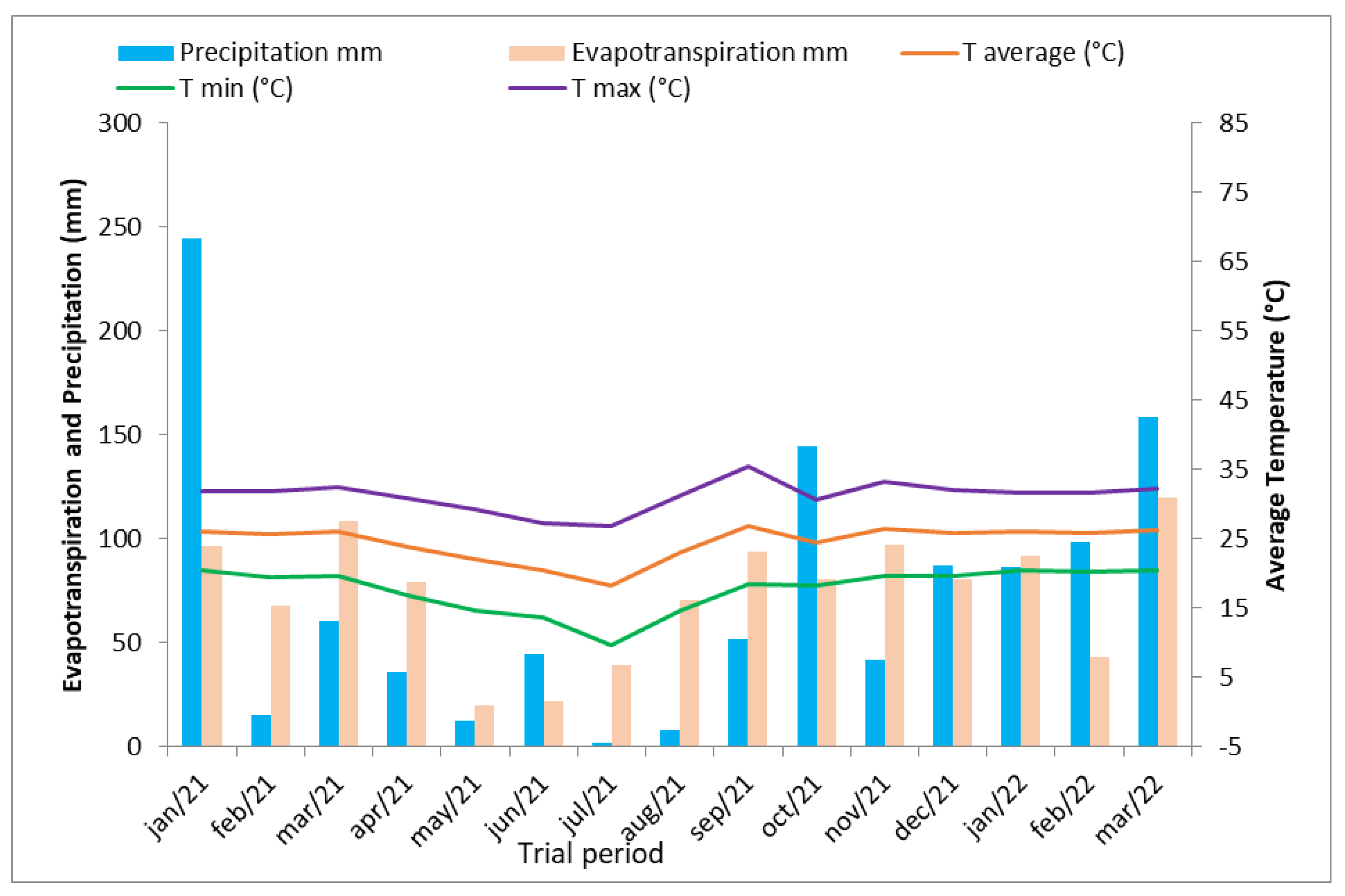

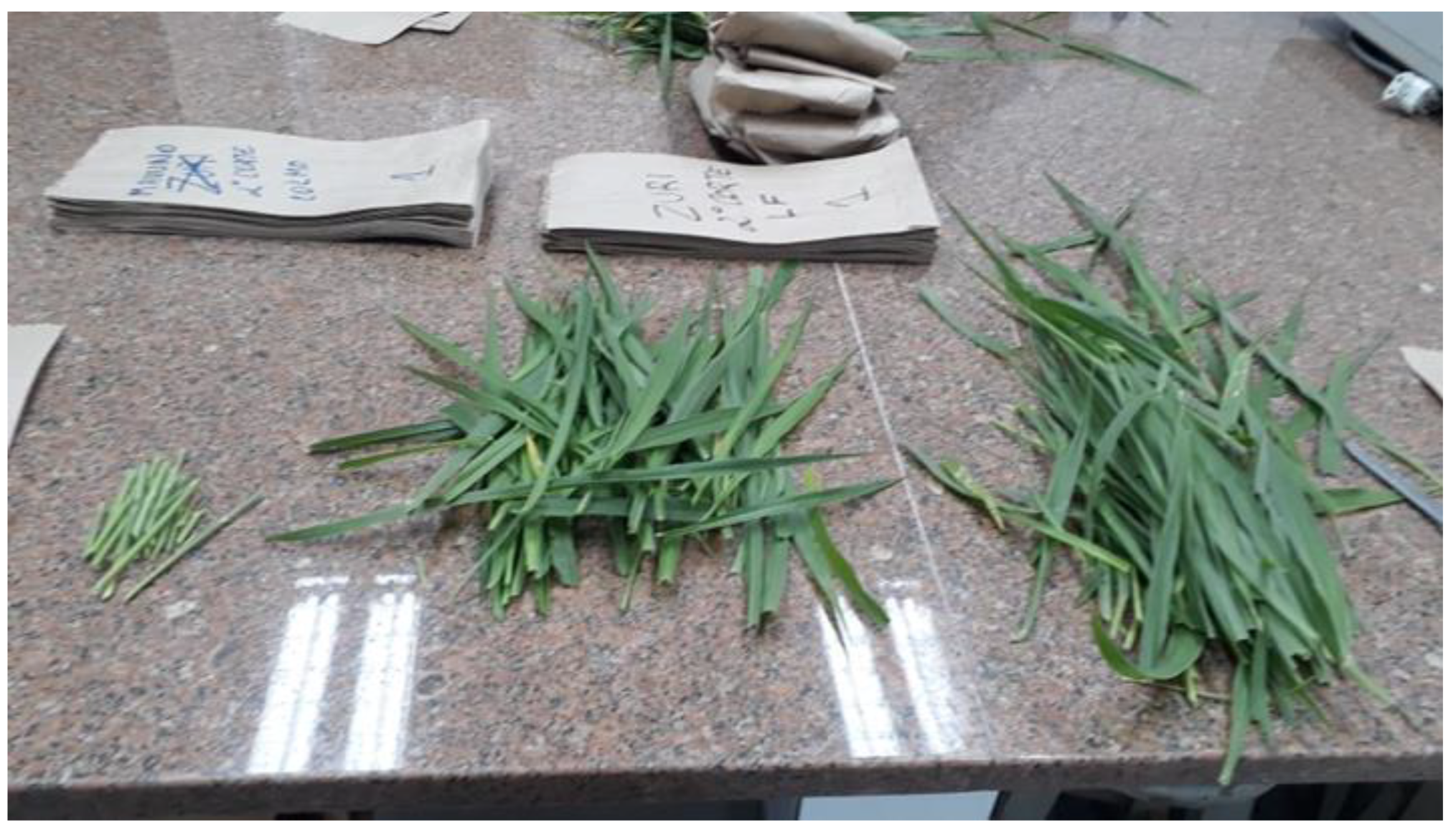
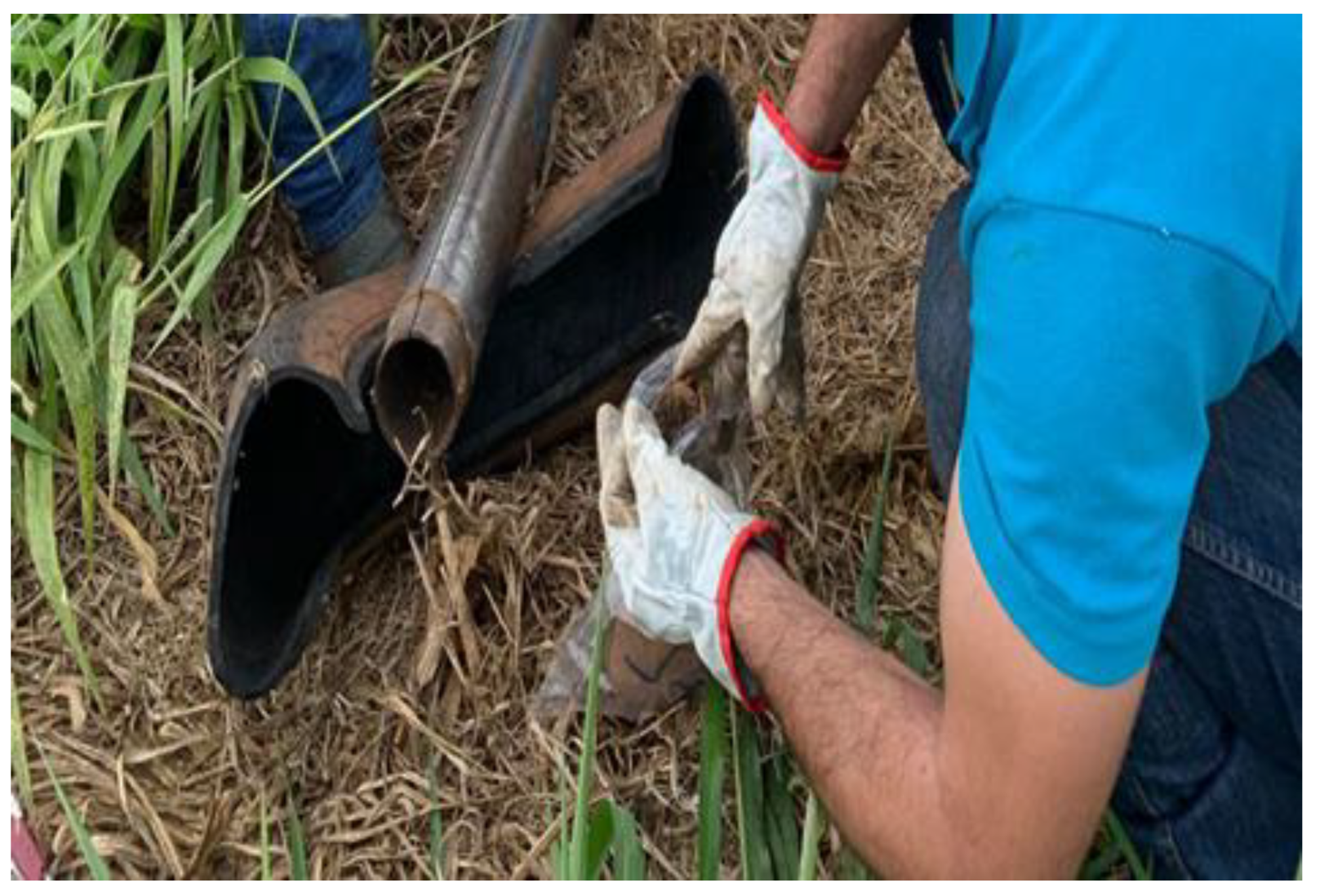

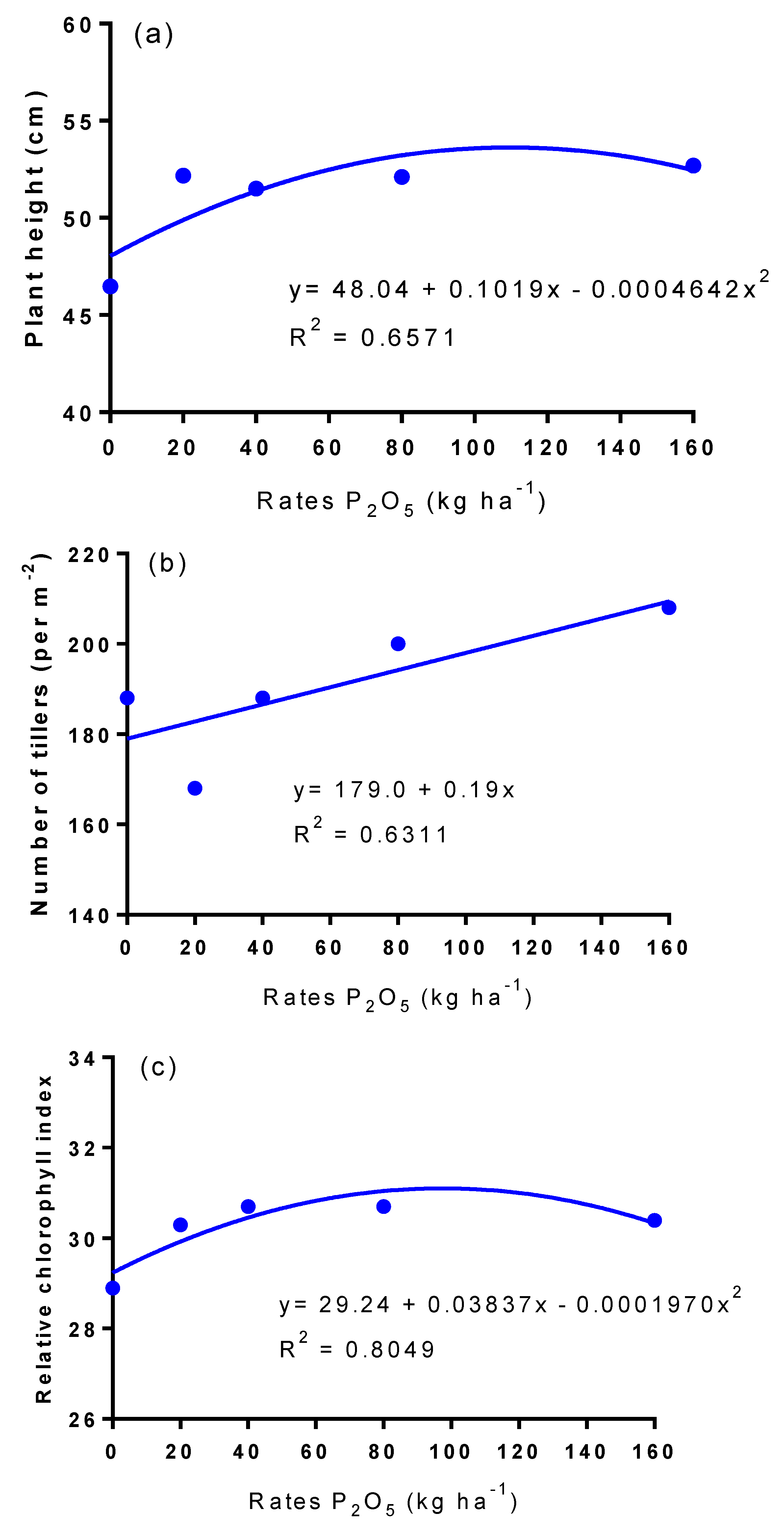
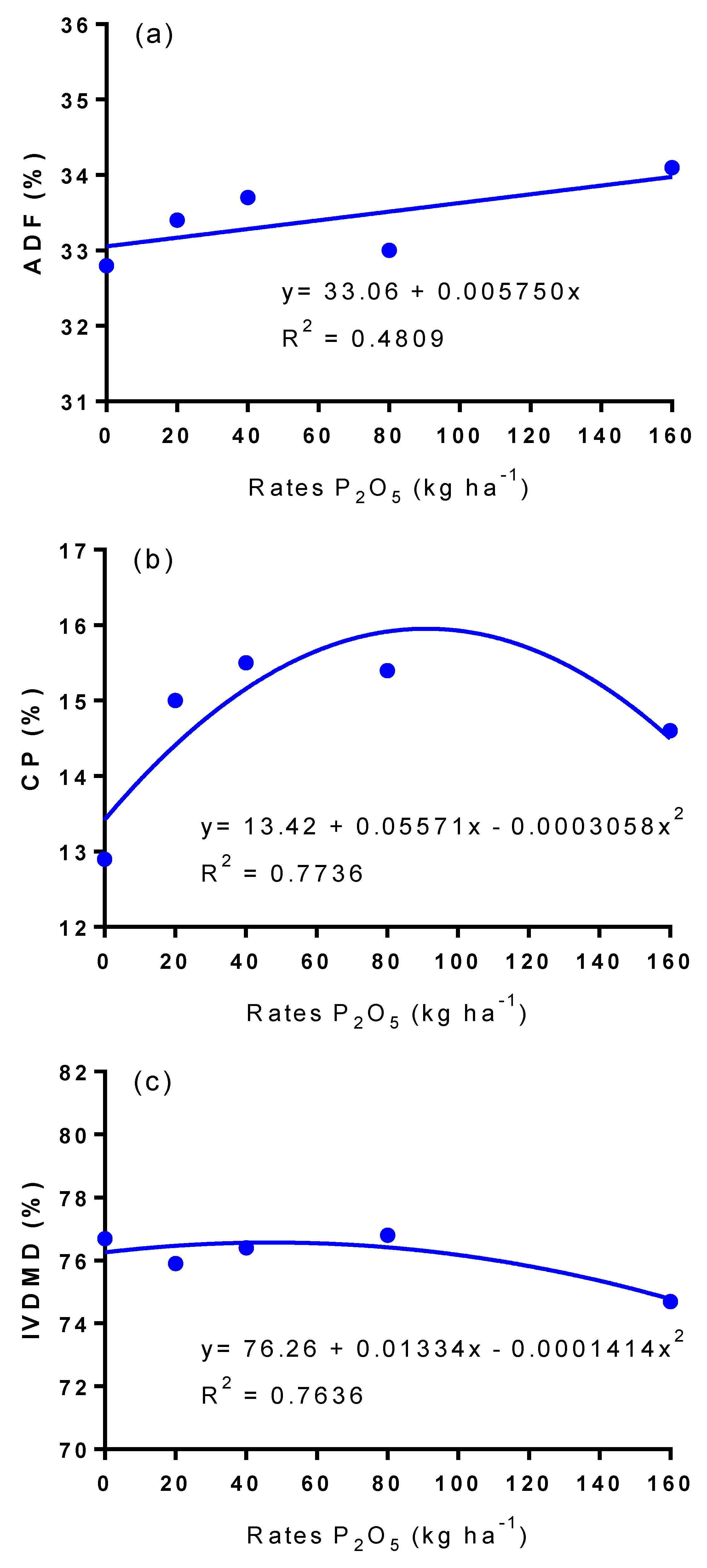
| Rates P2O5 (kg ha−1) | SDWY Accumulated | SDWY Summer | SDWY Winter | RDWY *** |
|---|---|---|---|---|
| ------------------------- (Mg ha−1) --------------------------------------- | (kg m−3) | |||
| 0 | 15.19 | 11.18 | 4.01 | 8.52 |
| 20 | 18.09 | 13.90 | 4.19 | 6.87 |
| 40 | 18.78 | 14.06 | 4.42 | 6.50 |
| 80 | 19.11 | 14.38 | 4.42 | 9.30 |
| 160 | 19.63 | 15.10 | 4.53 | 8.33 |
| Polymers | ||||
| Absence | 18.09 | 13.74 | 4.34 | 7.52 |
| Presence | 18.24 | 13.70 | 4.53 | 8.02 |
| Pr ≥ F | ||||
| Sources | 0.7452 | 0.9086 | 0.5078 | 0.3317 |
| Rates | 0.0001 ** | 0.0001 ** | 0.4208 | 0.0265 * |
| Sources × Rates | 0.6367 | 0.9473 | 0.5420 | 0.2179 |
| Means | 18.16 | 13.72 | 4.43 | 7.77 |
| CV (%) | 7.99 | 8.43 | 20.49 | 20.30 |
| Rates P2O5 (kg ha−1) | Mean Dry Weight Yield of Shoots (Mg ha−1) | Herbage Accumulated (kg ha−1 day−1) |
|---|---|---|
| 0 | 2.17 | 42.7 |
| 20 | 2.58 | 51.4 |
| 40 | 2.68 | 51.6 |
| 80 | 2.73 | 52.5 |
| 160 | 2.80 | 55.8 |
| Polymers | ||
| Absence | 2.58 | 50.9 |
| Presence | 2.60 | 50.7 |
| Pr ≥ F | ||
| Sources | 0.7885 | 0.9287 |
| Rates | 0.0001 ** | 0.0001 ** |
| Sources × Rates | 0.7867 | 0.9396 |
| Means | 2.59 | 50.8 |
| CV (%) | 25.84 | 26.03 |
| Rates P2O5 (kg ha−1) | Plant Height (cm) | Number of Tillers (Number m−2) | Relative Chlorophyll Index | Leaf Blade Percentage |
|---|---|---|---|---|
| 0 | 46.48 | 188 | 28.9 | 72.4 |
| 20 | 52.18 | 168 | 30.3 | 70.9 |
| 40 | 51.51 | 188 | 30.7 | 72.1 |
| 80 | 52.11 | 200 | 30.7 | 73.0 |
| 160 | 52.69 | 208 | 30.4 | 72.1 |
| Polymers | ||||
| Absence | 51.64 a | 208 | 30.3 | 72.0 |
| Presence | 50.35 b | 204 | 30.1 | 72.2 |
| Pr ≥ F | ||||
| Sources | 0.0260 * | 0.3947 | 0.5589 | 0.8017 |
| Rates | 0.0001 ** | 0.0044 * | 0.0001 ** | 0.5130 ns |
| Source × Rates | 0.1081 | 0.2567 | 0.2171 | 0.8829 |
| Means | 50.99 | 206.32 | 30.2 | 72.11 |
| CV (%) | 9.44 | 26.22 | 7.27 | 8.73 |
| Rates P2O5 (kg ha−1) | NDF | ADF | CP | IVDMD |
|---|---|---|---|---|
| --------------------------------------------------------- % -------------------------------- | ||||
| 0 | 67.3 | 32.8 | 12.9 | 76.7 |
| 20 | 67.7 | 33.4 | 15.0 | 75.9 |
| 40 | 67.8 | 33.7 | 15.5 | 76.4 |
| 80 | 67.0 | 33.0 | 15.4 | 76.8 |
| 160 | 67.6 | 34.1 | 14.6 | 74.7 |
| Polymers | ||||
| Absence | 67.4 | 33.5 | 14.8 | 76.2 |
| Presence | 67.6 | 33.4 | 14.6 | 76.0 |
| Pr ≥ F | ||||
| Sources | 0.2514 | 0.5702 | 0.6866 | 0.5727 |
| Rates | 0.1267 ns | 0.0016 ** | 0.0047 ** | 0.0001 ** |
| Sources × Rates | 0.5698 | 0.2146 | 0.4842 | 0.1064 |
| Means | 67.5 | 33.4 | 14.7 | 76.1 |
| CV (%) | 2.63 | 5.59 | 26.67 | 3.50 |
Disclaimer/Publisher’s Note: The statements, opinions and data contained in all publications are solely those of the individual author(s) and contributor(s) and not of MDPI and/or the editor(s). MDPI and/or the editor(s) disclaim responsibility for any injury to people or property resulting from any ideas, methods, instructions or products referred to in the content. |
© 2023 by the authors. Licensee MDPI, Basel, Switzerland. This article is an open access article distributed under the terms and conditions of the Creative Commons Attribution (CC BY) license (https://creativecommons.org/licenses/by/4.0/).
Share and Cite
Prudencio, M.F.; de Almeida, L.J.d.C.; Moreira, A.; Freitas, G.d.S.; Heinrichs, R.; Soares Filho, C.V. Effect of Phosphorus-Containing Polymers on the Shoot Dry Weight Yield and Nutritive Value of Mavuno Grass. Agronomy 2023, 13, 1145. https://doi.org/10.3390/agronomy13041145
Prudencio MF, de Almeida LJdC, Moreira A, Freitas GdS, Heinrichs R, Soares Filho CV. Effect of Phosphorus-Containing Polymers on the Shoot Dry Weight Yield and Nutritive Value of Mavuno Grass. Agronomy. 2023; 13(4):1145. https://doi.org/10.3390/agronomy13041145
Chicago/Turabian StylePrudencio, Marcelo Falaci, Lucas José de Carvalho de Almeida, Adônis Moreira, Gabriela da Silva Freitas, Reges Heinrichs, and Cecílio Viega Soares Filho. 2023. "Effect of Phosphorus-Containing Polymers on the Shoot Dry Weight Yield and Nutritive Value of Mavuno Grass" Agronomy 13, no. 4: 1145. https://doi.org/10.3390/agronomy13041145
APA StylePrudencio, M. F., de Almeida, L. J. d. C., Moreira, A., Freitas, G. d. S., Heinrichs, R., & Soares Filho, C. V. (2023). Effect of Phosphorus-Containing Polymers on the Shoot Dry Weight Yield and Nutritive Value of Mavuno Grass. Agronomy, 13(4), 1145. https://doi.org/10.3390/agronomy13041145






